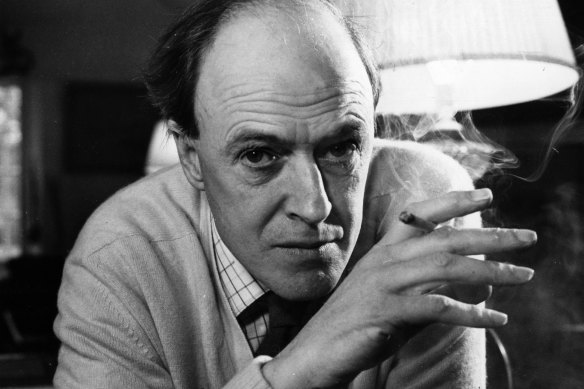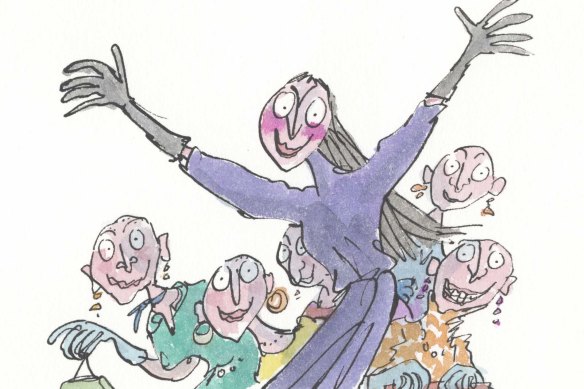This was published 2 years ago
Opinion
Augustus Gloop is no longer fat. He’s enormous. And that’s sweet with me
Andy Griffiths
Children's authorAnother year, another Roald Dahl controversy. It’s getting like you can set your watch – or should I say digital timing device – by them. A “slut” here. An “oompa loompa” there. A “big fat” somebody or other everywhere. Gee, it’s as if the bloke was writing 50 years ago in a completely different time and in a far less progressive culture.
So, I’m not surprised – or particularly disturbed – by the fact that it has been deemed necessary to make a number of changes to the words in classic books like The Witches and Charlie & The Chocolate Factory. Words like “fat” and “mad” and descriptions of women as “fearfully ugly” and having “horse-shaped faces” might have been – and clearly were – perfectly acceptable in the second half of the 20th century when they were written, but thankfully they have been recognised as offensive, and called out as such.

It’s as if the bloke was writing 50 years ago in a completely different time and in a far less progressive culture.Credit: Getty
Rather than rushing to blame or cancel the author, however, we should congratulate Dahl on creating such truly memorable characters and stories that we’re still reading his books today. Likewise, we need to respect the delicate tightrope that a modern publisher must walk between preserving the original text and making it palatable to a society which values diversity and inclusivity.
Language is dynamic – it changes constantly and has done so since the first apes uttered their first grunts and the first scribes committed the first words to papyrus. Words are both shaped by the culture in which they appear and have enormous power to shape the culture in turn – especially as to what we deem “normal”. As we gain greater awareness and sensitivity towards all the different groups and types of people that make up our society, it’s entirely appropriate that we cast a sensitive ear to the words we use to speak to each other both in everyday life and in books for children.
I’ve only been writing for a mere 25 years and have already noticed that some of the words from my earliest books in the mid-90s are not words I would choose – or care to use – now. I have quietly deleted or changed them when I’ve had the opportunity and don’t feel that I’ve compromised the integrity of the stories one iota. Children’s books are not sacred texts, they are living breathing collaborations between the writer’s words and the active imagination of the reader.
Words that might reasonably be predicted to upset or offend sections of the audience are, in most cases, better off being replaced (unless, of course, your intention is to deliberately upset and offend). This is part of the completely normal, and exhaustive, process of editing and rewriting.
Most people are surprised to learn that the word “poo” never appears in my novel The Day My Bum Went Psycho, and the word “fart” only once. This was not due to squeamishness on my part but because I noted that in test readings the audiences laughed much louder when I implied both of these words rather than bluntly stating them.
Rewriting normally ceases once a book has been published, but in the case of books that have outlived the times in which they were written I think an argument for a sensitive consideration of whether the word-choice matches current sensitivities is justified.
Mind you, I’m talking about the words, not the content. I will defend the right – in fact the duty – of any writer for young children to present their audiences with the most imagination-stretching, slosh-funking, whiz-popping, thought-provoking, irreverent, silly, startling, funny, sad and powerfully involving content they are capable of dreaming up. And Roald Dahl does that in spades, another reason why his books are still being read so enthusiastically today.
Any creator of books for children must be aware that their book may be a child’s first encounter with the world of literature, and if the book is not written with great care, love, energy and respect for the often messy, chaotic, hilarious and terrifying business of pure story, it may well be their last.

Changes were also made to The Witches.Credit: © Quentin Blake
Not that any of this is easy. As Tim Winton has noted, when you’re writing for children you’re actually writing for three audiences: yourself, the child and, of course, the gatekeepers: parents, teachers, booksellers and librarians who purchase and, in many cases, read the books along with their children.
Like Dahl, Enid Blyton and many others, my books have on occasion fallen foul of well-meaning gatekeepers who sometimes have a completely different idea from the children as to what constitutes a “good” children’s book. They can be prone to worrying that if a child reads about a character behaving badly or in a dangerous way that the child will take this as tacit endorsement of the behaviour and try to replicate it in real life.
But it’s not quite that simple, and I’m pretty sure Dahl knew that. Children are more than capable of telling the difference between what’s appropriate in the world of a book and what’s appropriate behaviour in real life. When writing for children, Dahl believed in the power of exaggeration. His good characters are very very good, and his bad characters very very bad indeed. In fact, it’s that very difference in which lies the whole appeal of books – a chance to experience vicariously what happens when normal reality is turned on its head and the rules of polite society are suspended.
This, however, is not an argument for the careless or outdated use of the language in which a story is written. Words matter. A lot. Any Snozzwanger, Quogwinkle or Human bean knows that.
The Opinion newsletter is a weekly wrap of views that will challenge, champion and inform your own. Sign up here.